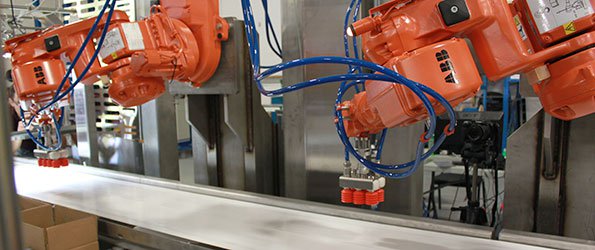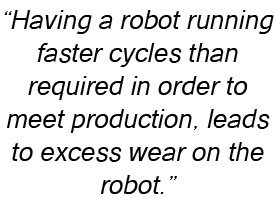
How to Get the Most Life Out of Your Industrial Robot
Colin Shipley | 30 April 2015
There are several ways an industrial robot can wear out sooner than intended. On average, most companies plan to get more than eight years of service out of a robot. However, some companies have robots that are still running after nearly 20 years. What causes some companies to get more or less use out of their robots? There are several common mistakes that can easily shorten the life of a robot to be around four years or even less. The examples and solutions I will provide in this article are based on ABB and FANUC robots but the principles are applicable across all brands.
Tool and Load Definitions
 Two factors commonly used to correctly ramp up/down the motors on the robot are the amount of weight and the location of the weight. If these definitions are wrong, the amplifier will over/under power the motor. This will be detected due to the feedback of the encoder, and then the motor will have to correct the output with more/less power. This puts additional stress on the amplifier and can be taxing on the mechanical unit. We recommend the weight definition be as accurate as possible.
Two factors commonly used to correctly ramp up/down the motors on the robot are the amount of weight and the location of the weight. If these definitions are wrong, the amplifier will over/under power the motor. This will be detected due to the feedback of the encoder, and then the motor will have to correct the output with more/less power. This puts additional stress on the amplifier and can be taxing on the mechanical unit. We recommend the weight definition be as accurate as possible.
For a robot that picks up a variety of product or an inconsistent product, we recommend keeping the defined load accurate within 5% of the robot’s payload rating. For example, a FANUC R2000iC 165F (rated at 165kg) should have its payload (tool product) be defined within 8.25 kg or 18 lbs. It is strongly recommended to weigh the tool on a scale to get the accurate weight. Some robots do have the capability to estimate the weight but these methods are never as accurate as a true scale.
Another important aspect is assembling a payload schedule. When the robot picks up the product, the weight it is subsequently handling increases. FANUC allows you to set up different payloads to represent an empty tool as well as a tool with product. ABB has you define them separately then activate which product load the robot is holding. A very common mistake made when setting up ABB’s product load is to measure the center of gravity from the faceplate, instead of properly from the active TCP.
Collision Detection
Robots have the ability to detect an abnormal load and stop the robot before too much damage occurs. The biggest limitation is speed. If the robot is running near full speed, it won’t have enough of a reaction time to stop before much damage occurs. The first step toward proper collision detection is accurately defining the payload. Next, increase the sensitivity until false alarms occur. Lastly, continue to gradually decrease the sensitivity until these nuisance alarms stop occurring altogether.
Duty cycle
 Rarely do people use the full acceleration of their vehicle every time they go from 0 to 35 MPH. Rarely do people carry around the capacity of their vehicle everywhere they go. The same things ring true for industrial robots. Having a robot running faster cycles than required in order to meet production, leads to excess wear on the robot.
Rarely do people use the full acceleration of their vehicle every time they go from 0 to 35 MPH. Rarely do people carry around the capacity of their vehicle everywhere they go. The same things ring true for industrial robots. Having a robot running faster cycles than required in order to meet production, leads to excess wear on the robot.
Slowing the robot down via program speeds or override percentage helps reduce wear on the controller and mechanical unit. Both ABB and FANUC offer software that can help estimate what percentage of the robot’s capacity you are using and can help estimate the remaining life of the robot. This estimate is mostly about how long until the amplifier or other key component will wear out. This allows the robot to be used efficiently for a longer period of time.
Environmental Protection
Dust, mist, and other hazards are hard on electronics and even mechanical units. Not all robots are IP67 or even IP65-certified for protection against these contaminants. In machine tending where coolant is everywhere, a robot that is completely liquid tight is important. The mist that can be generated in these environments is also a danger to the controller. Generally, controllers are IP54-certified but if you think you might need a dust-tight and water-tight enclosure, verify that the controller will handle it. There are filters available to help keep the dust out of the controller along with jackets and covers to keep dust and liquid out of sensitive spots on the robot arm. These are a must when the base level of protection isn’t enough.
Proper Stopping Technique
Do not allow the robot to be stopped in its operation by using the emergency stop or other safety stop methods except when in an emergency condition. Using these methods could lead to early break failure. When used as intended, the brakes should not exhibit wear because they hold the robot still. Forcing a robot to stop by pressing an emergency stop or opening other forms of safety circuits causes excessive wear. When the breaks wear down, the robot will start to creep out of position when the brakes are in use. A robot should be stopped by pressing a request to enter on a control system or the hold button on FANUC or the square stop button on ABB. This has the robot either complete its current cycle before allowing access or ramps down the motion while maintaining its current path.
Preventative maintenance (PM)
Like every other gearbox out there, the oil/grease needs to be changed after a period of time to keep the optimal lubrication properties and to clean out any grit that has collected. There is a schedule provided by both ABB and FANUC that informs the intervals in which certain PM work is required. The tooling and wiring bundles should also be inspected for wear in order to help prevent extended downtime due to failure. Bastian Solutions is able to assist in implementing any changes needed to help extend the life of an industrial robot.
Comments
No comments have been posted to this Blog Post
Leave a Reply
Your email address will not be published.
Comment
Thank you for your comment.